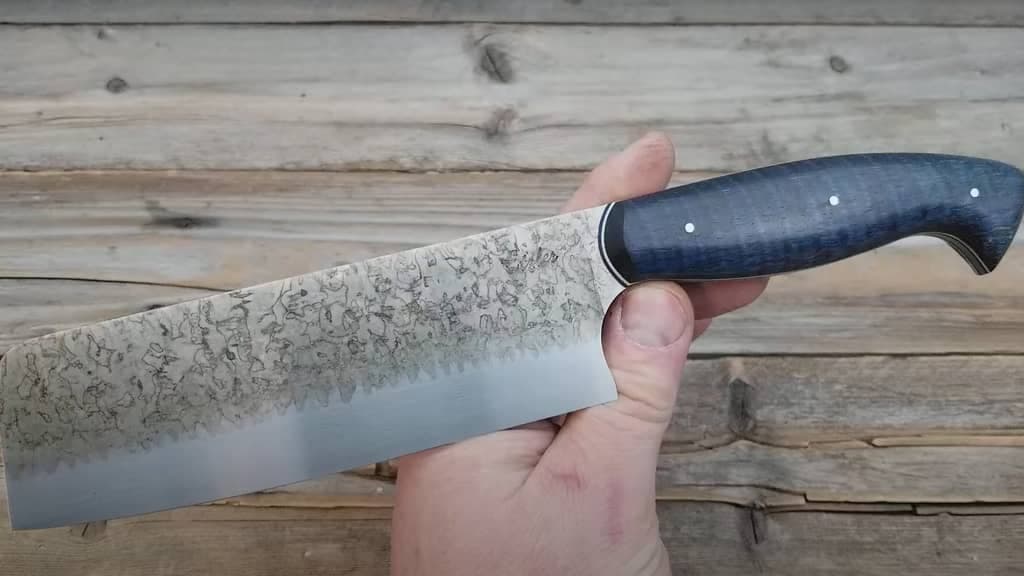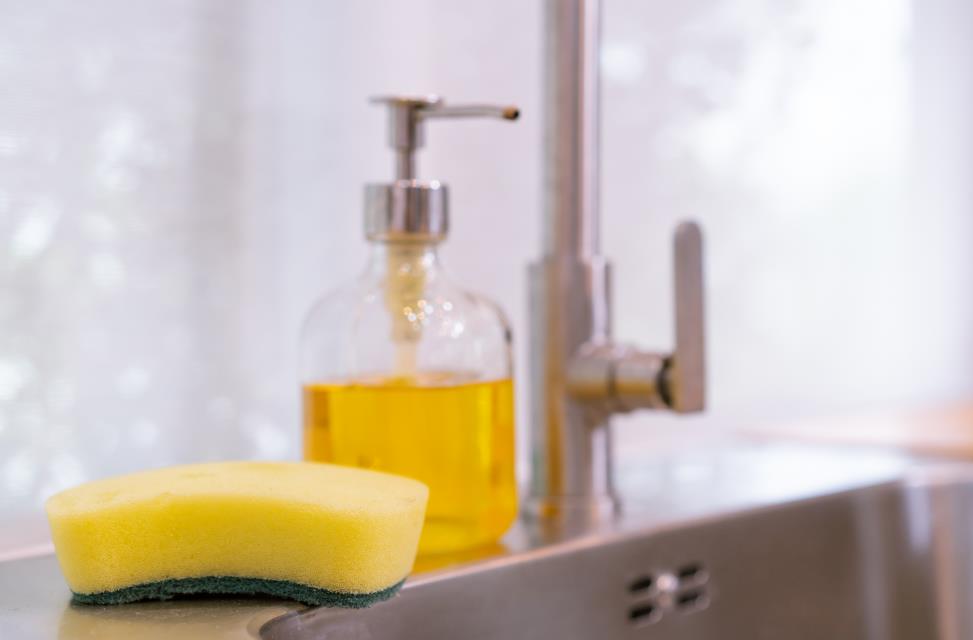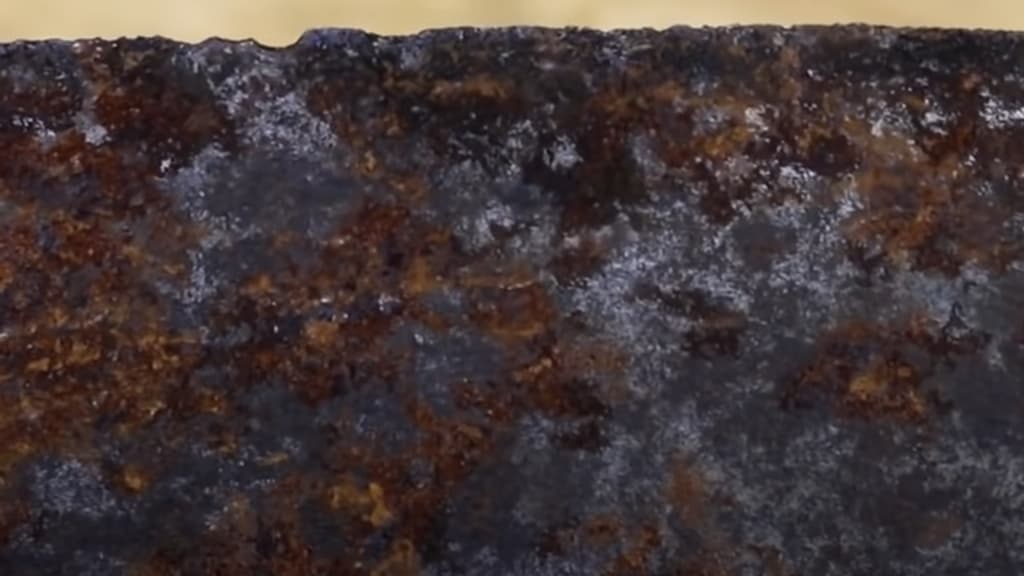Carbon steel knives are a preferred choice among all kinds of cooks. Whether you cook at home for your family and guests or cooking is your profession, utilizing carbon steel knives in the kitchen can assist you in many ways.
One thing that carbon steel knives are known for is they form a protective layer called patina over time. The patina on a carbon steel knife is easy to detect as it darkens the blade. Patina is a natural oxidation process that develops over time on high-carbon blades. It prevents the knife from undergoing additional oxidation that may ultimately result in rust. More on this later.
Some find patina visually appealing; some think it makes the knife lose its aesthetic appeal, the main reason being that the knife doesn’t shine anymore. If you think kitchen knives turning darker is a downside, know that the advantages of carbon steel knives still outweigh their disadvantages.
In this article, we’ll explain the ways to force and remove a patina, how patina compares to rust, and everything else you need to know about patina on a carbon steel knife.
Table of contents
What is patina and how does it emerge?
On carbon steel knives, patina is a type of corrosion that darkens the blade. It’s a thin layer of iron oxide that can include other elements like sulfur, ferric nitrate, carbonate, and other oxides. The patina on carbon steel knives is generally the first sign of aging.
Though removable, patina is a natural protective cover that shields the blade from further oxidation. If carbon steel knives didn’t form a patina, oxidation would damage it to the point where it breaks and alters the food’s taste.
When the oxygen in the air interacts with your carbon steel knife, the atoms react to it, forming patina. This process happens a lot faster under a moisture environment.
Simply cutting food with your carbon steel knife will leave traces of food on the blade. Patina will start to surface on carbon steel with food traces or moisture in as soon as 15 minutes.
The whole process of patina emerging on a carbon steel knife is similar to an apple turning brown after it’s cut. Exposure to air and moisture is what drives the patina to come out on a knife.
If you do not carefully clean your knife with a cloth after every use, the food residues will cause the patina to emerge faster.
The patina on carbon steel can appear quickly, especially with citric-acidic foods like tomato and lemon. It is suggested to rinse and dry your knife after every use if you don’t want patina.
What does patina do to your knife?

As mentioned, patina is a thin layer of corrosion that protects the carbon steel from further oxidation and rust. It gives the carbon steel knife a matte finish. However, patina won’t alter the food’s taste and look when you cut with it, unlike rust.
For some, the patina enriches the blade’s color as carbon steel is not as shiny as other types of metals used in the kitchen. It’s also a good way to know that your carbon steel knife is aged properly.
When cared for well, carbon steel knives don’t need a patina. You can have a perfectly working, rust-free carbon steel knife without patina. Frequent cleaning, leaving dry, and sharpening your carbon steel knife is enough to preserve it for the most part.
If caring for your knife regularly isn’t something you’re interested in doing often, letting patina surface is a natural way to protect it. Consider forcing patina on your carbon steel knife and use your spare time trying out new recipes or improving your cutting skills.
However, just because there is a decent patina on your carbon steel knife doesn’t mean that you should neglect caring. Make sure to give your knife the attention it needs to prolong its lifespan. When given proper care, a well-made carbon steel knife can last for over a decade in your kitchen.
Handpicked for you
True cutting power in the palm of your hand
How to form a patina on your knife?
Though it may take a while if you’re regularly cleaning and keeping your carbon steel knife dry, the patina will emerge eventually. If you’re not so keen on caring for your knife as much, this process will happen rather quickly but not as instant as forcing patina on a carbon steel knife yourself.
Letting patina form naturally
One of the characteristics of carbon steel knives is that they will form a patina. The longer you have it, the greater the patina is going to be on the blade. There are ways to get in the way of a carbon steel knife forming a patina, but there is no method to prevent it entirely.
As mentioned above, oxygen alone will cause the patina to emerge on metal that doesn’t have anti-corrosive abilities. Considering that there is no way to suffocate your knife physically, even leaving your knife in your kitchen drawer will make it develop a patina gradually.
Having that said, the patina will slowly appear naturally on your knife even if you leave it be and don’t use it. The more you use your carbon steel knife for its intended purpose – chopping and slicing foods – the faster this will happen.
Here is how you can take matters into your hands when you want to force a patina on carbon steel blades.
Forcing patina to emerge on a carbon steel blade
All carbon steel knives develop a patina eventually. After some use, you will notice patina forming on the blade, so it’s not a must to force it. If you want to speed up the process to prevent rusting on the blade early on or create your own decorations, forcing patina is the way to go.
There are many methods used to force patina to come out on carbon steel, but the easiest ways are as follows.
What you will need
- Vinegar
- An applicator (paper towel, paintbrush, etc.)
- Stretch film/wrap
You can also use regular store-bought mustard, especially if you want to create different patterns on the knife, as the texture is more convenient to work with on the blade. When you’re decorating the knife, you might want to use a paintbrush instead of a paper towel.
Follow these steps to force a patina on your carbon steel knife
- Put the vinegar in a cup and soak the paper towel.
- Wrap the paper towel around the blade of the knife only. Getting the vinegar in contact with the handle can alter its color, which is not what we want.
- Wrap the stretch film/wrap around the paper towel.
- Let the knife sit for 10 to 15 minutes.
- Unwrap everything and rinse the vinegar using water and dry the blade with a towel.
As a general rule, the longer you keep the blade with vinegar or mustard, the darker the patina is going to be. It takes more work to remove the patina from your knife than forcing it, so it’s best to let the blade sit for shorter periods and reapply as needed until you reach the desired color range.
If there is patina on the knife already before forcing it, these areas will be darker. Use patches of paper towel in the rest of the blade, or apply vinegar or yellow mustard with a paintbrush to even the color.
How to remove patina off your blade

The same as forcing patina, there are many ways to remove patina off your blade. There are pros and cons to some of the methods, so we listed them out for you. Follow the way the most convenient for you and your knife.
Metal polish (Flitz, Simichrome, etc.)
Apply a little bit of Flitz metal polish on the blade and leave it for a minute or two. Remove the polishing using a paper towel by applying pressure.
Pros
- Metal polishing gives anti-corrosive abilities
- Revives back the shiny of the blade
- Takes very little time and easy to use
Cons
- Doesn’t remove the majority of strong patina
- Some metal polish may have a strong, unpleasant smell
Steel wool
Make sure the blade and the steel wool are dry. If either one of them is wet, it will create rust rather than removing the patina. Get started by rubbing the dry steel wool along the polishing grain of the blade and continue until the patina is removed.
Pros
- Removes most patina off the blade, particularly if not too strong.
- Cheap option
Cons
- Takes time
- Rubbing and pressing on the blade can get exhausting
- May scratch the blade
Rust eraser
Wet the blade and rub the rust eraser. The same with steel wool, rub by the polishing grain of the blade.
Pros
- Serves the intended purpose
- Lasts a long time
- Removes the majority of patina
Cons
- Finding a rust eraser for carbon steel is often challenging
Metal sandpaper
With a few drops of water, rub the metal sandpaper, preferably aluminum oxide or silicon carbide sandpaper, then dry the knife with a paper towel or cloth.
Pros
- Removes the majority of patina
- Easy to use
- Polishes the blade well
Cons
- Quite expensive (a pack can cost about $20)
- Can scratch the blade
Citric acid
In a deep enough container like a jar, add enough warm water to wet the blade, but not the handle. Pour about three to four tablespoons of citric acid, depending on the size of the blade, and stir. Put the knife in the mix and let it wait for an hour. Take the knife out after the time is up and scrub with dish soap using a dish brush or scouring pad. Lastly, rinse and dry the knife as always.
Pros
- Removes most of the patina
- Doesn’t require much work
Cons
- Multi-step process
- Risk of damaging the handle
- Takes time
Differences between rust and patina
If you just got a brand new carbon steel knife and notice black spots on it while knowing nothing about them, it’s normal to confuse them for rust.
Rust and patina are mistaken for each other commonly, but they are very different both chemically and appearance-wise.
The clear difference between rust and patina is the color. Rust appears as a red-orange mix color resembling an almost brown, while patina is generally grey and black. The patina on carbon steel blades mostly appears black, dark grey, hues of blue, or a mix of them.

Rust is also significantly more dangerous than patina. After all, nobody intentionally forces rust on metal surfaces.
Patina won’t cause any damage to you or the food you cut, but the same can’t be said with rust. If it gets into your bloodstream or you get a cut with a rusty knife, it can lead to serious medical problems or even death.
How to prevent rust on a carbon steel knife?
As carbon steel knives don’t have anti-corrosive attributes, they can rust. Patina protects the blade from further oxidation and gets in the way of the rusting process significantly, but rust can still form if not careful.
When you’re utilizing a carbon steel knife in your kitchen, there are a few habits you need to have to pick up rusting. Rather than throwing it in the sink after use, dry your carbon steel knife with a cloth when you’re not using it. It’s best to wash a carbon steel knife with dish soap, rinse, and dry before putting it away.
Since that isn’t convenient when you have a cooking marathon in front of you, it’s best to dry it with a cloth to get rid of the moisture. You can wash and dry it finally before storing it in your knife holder. Additionally, applying a coat of food-safe mineral oil will create a barrier between the blade and the surrounding air. This also prevents further oxidation in carbon and high carbon steel knives.
Conclusion
Overall, carbon steel is a great knife material that can give your kitchen more character, and it can be fun to use. The patina on the carbon steel knife is the most important characteristic of the blade. It’s usually the first thing people notice to identify a carbon steel knife.
With enough care, your carbon steel knife will go a long way in your kitchen, outliving most of your kitchen utensils over the years. After all, they have proven themselves to be reliable for centuries. Check out our handmade carbon steel knives to grab yourself one.












